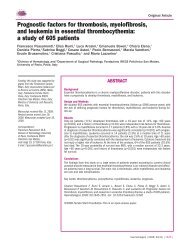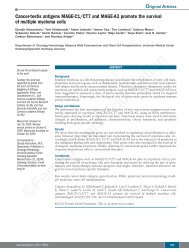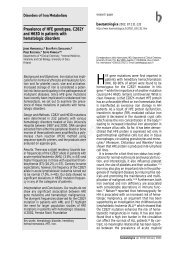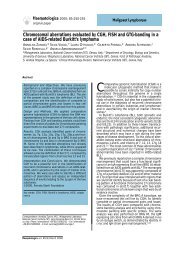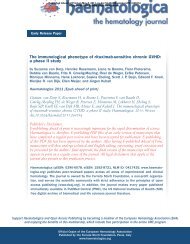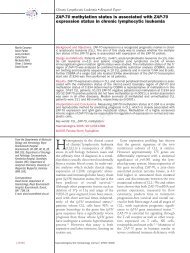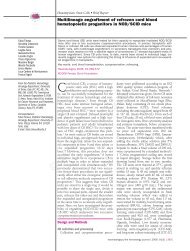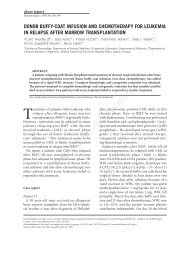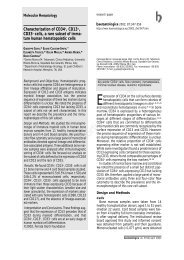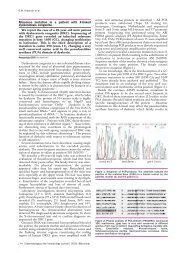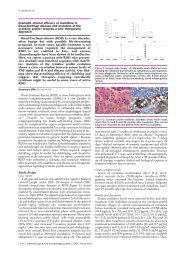Mini-ICE regimen allows mobilization of peripheral blood progenitor ...
Mini-ICE regimen allows mobilization of peripheral blood progenitor ...
Mini-ICE regimen allows mobilization of peripheral blood progenitor ...
Create successful ePaper yourself
Turn your PDF publications into a flip-book with our unique Google optimized e-Paper software.
ance was excellent and hematologic and non-hematologic<br />
toxicities were milder than with the <strong>ICE</strong> <strong>regimen</strong>.<br />
Moreover, days <strong>of</strong> neutropenic fever, hospitalization<br />
and consumption <strong>of</strong> antibiotics were reduced.<br />
Unfortunately, no cytogenetic response was obtained.<br />
To date the patient has been transplanted with full<br />
engraftment and no major complications.<br />
Several factors have been associated with the ability<br />
and capacity to mobilize hemopoietic <strong>progenitor</strong><br />
cells in CML such as intensity and type <strong>of</strong> chemotherapy,<br />
time from diagnosis, phase <strong>of</strong> the disease<br />
and previous treatment with IFN-�. 3-8 Our patient<br />
had several <strong>of</strong> these bad prognostic factors in both<br />
<strong>mobilization</strong> attempts. Although more intensive<br />
chemotherapy <strong>regimen</strong>s have been associated with<br />
better <strong>mobilization</strong>, in our patient, the milder mini-<br />
<strong>ICE</strong> <strong>regimen</strong> was associated with successful <strong>mobilization</strong><br />
and with milder hematologic and non-hematologic<br />
toxicities. A similar observation has been<br />
recently reported. 9,10 Furthermore, the mini-<strong>ICE</strong> <strong>regimen</strong><br />
showed no difference in terms <strong>of</strong> cytogenetic<br />
response or <strong>progenitor</strong> yield when compared with the<br />
<strong>ICE</strong> <strong>regimen</strong>. 9,10 Although additional patients are necessary<br />
to confirm our data, they suggest that a second<br />
attempt to mobilize <strong>progenitor</strong> hemopoietic cells<br />
using the well-tolerated mini-<strong>ICE</strong> <strong>regimen</strong> should be<br />
tried in patients who have failed to get benefit from<br />
other intensive chemotherapy <strong>regimen</strong>s.<br />
Antonio Salar, Anna Sureda, Bárbara Menéndez, Jorge Sierra<br />
Clinical Hematology Division,<br />
Hospital de la Santa Creu i Sant Pau, Barcelona, Spain<br />
Key words<br />
Chronic myelogenous leukemia, mini-<strong>ICE</strong> <strong>regimen</strong>, <strong>ICE</strong><br />
<strong>regimen</strong>, <strong>mobilization</strong>, <strong>peripheral</strong> <strong>blood</strong> <strong>progenitor</strong> cells.<br />
Correspondence<br />
Antonio Salar, M.D., Clinical Hematology Division, Hospital<br />
de la Santa Creu i Sant Pau, Sant Antoni Maria i Claret<br />
167, 08025 Barcelona, Spain.<br />
Phone: international +34-93-2919396 – Fax: International<br />
+34-93-2919466 – E-mail: asalar@hsp.santpau.es<br />
References<br />
1. McGlave PB, De Fabritiis P, Deisseroth A, et al. Autologous<br />
transplants for chronic myelogenous leukaemia;<br />
results from eight transplant groups. Lancet 1994;<br />
343:1486-8.<br />
2. O’Brien SG, Goldman JM. Autografting in chronic<br />
myeloid leukaemia. Blood Rev 1994; 8:63-9.<br />
3. Carella AM, Podestá M, Frassoni F, et al. Collection <strong>of</strong><br />
“normal” <strong>blood</strong> repopulating cells during early hemopoietic<br />
recovery after intensive conventional chemotherapy<br />
in chronic myelogenous leukemia. Bone Marrow<br />
Transplant 1993; 12:267-71.<br />
4. Boqué C, Petit J, Sarrá J, et al. Mobilization <strong>of</strong> <strong>peripheral</strong><br />
stem cells with intensive chemotherapy (<strong>ICE</strong> <strong>regimen</strong>)<br />
and G-CSF in chronic myeloid leukemia. Bone<br />
Marrow Transplant 1996; 18:879-84.<br />
5. Johnson RJ, Owen RG, Chiold JA, et al. Mobilization <strong>of</strong><br />
Philadelphia-negative <strong>peripheral</strong> <strong>blood</strong> mononuclear<br />
cells in chronic myeloid leukaemia using hydroxyurea<br />
scientific correspondence 327<br />
and G-CSF. Br J Haematol 1996; 93: 863-8.<br />
6. Chalmers EA, Franklin IM, Kelsey SM, et al. Treatment<br />
<strong>of</strong> chronic myeloid leukaemia in first chronic phase<br />
with idarubicin and cytarabine: <strong>mobilization</strong> <strong>of</strong> Philadelphia-negative<br />
<strong>peripheral</strong> <strong>blood</strong> stem cells. Br J<br />
Haematol 1997; 96: 627-34.<br />
7. Carella AM, Cunningham I, Lerma E, et al. Mobilization<br />
and transplantation <strong>of</strong> Philadelphia-negative<br />
<strong>peripheral</strong>-<strong>blood</strong> <strong>progenitor</strong> cells early in chronic myelogenous<br />
leukemia. J Clin Oncol 1997; 15:1575-82.<br />
8. Mehta J, Mijovic A, Powles R, et al. Myelosuppressive<br />
chemotherapy to mobilize normal stem cells in chronic<br />
myeloid leukemia. Bone Marrow Transplant 1996;<br />
17:25-9.<br />
9. Carella AM, Lerma E, Celesti L, et al. Effective <strong>mobilization</strong><br />
<strong>of</strong> Philadelphia-chromosome-negative cells in<br />
chronic myelogenous leukaemia patients using a less<br />
intensive <strong>regimen</strong>. Br J Haematol 1998; 100:445-8.<br />
10. Sureda A, Petit J, Brunet S, et al. <strong>Mini</strong>-<strong>ICE</strong> <strong>regimen</strong> as<br />
<strong>mobilization</strong> therapy for chronic myelogenous<br />
leukaemia patients at diagnosis. Bone Marrow Transplant<br />
1999; 24:1285-90.<br />
Lamivudine for the prevention <strong>of</strong> hepatitis B<br />
virus reactivation during autologous stem cell<br />
transplantation. A case report<br />
Reactivation <strong>of</strong> hepatitis B virus (HBV) is a frequent<br />
complication during chemotherapy; it may<br />
give rise to hepatitis, hepatic failure and death and<br />
may prevent further chemotherapy from being<br />
administered. We present a case in which the use <strong>of</strong><br />
lamivudine allowed autologous stem cell transplantation<br />
to be performed after a hepatitis flareup,<br />
suggesting a possible role for this drug in preventing<br />
HBV reactivation during chemotherapy.<br />
Sir,<br />
Hepatitis B virus (HBV) reactivation following<br />
chemotherapy withdrawal may result in hepatitis,<br />
hepatic failure and death. 1,2 In fact, immunosuppressive<br />
therapy leads to enhanced viral replication<br />
and to an increased number <strong>of</strong> infected hepatocytes.<br />
Withdrawal <strong>of</strong> the drugs results in partial restoration<br />
<strong>of</strong> immunocompetence with subsequent rapid<br />
destruction <strong>of</strong> hepatocytes. 1 It was recently reported<br />
that nucleoside analogs such as lamivudine (a reverse<br />
transcriptase inhibitor approved for the therapy <strong>of</strong><br />
HIV infection) is effective in suppressing HBV replication<br />
by incorporation <strong>of</strong> its monophosphate form<br />
into DNA, which results in chain termination. 3<br />
We report the case <strong>of</strong> a 40-year old male, known to<br />
be HBsAg positive for 17 years, without any signs <strong>of</strong><br />
active hepatitis, who was diagnosed as having mantle<br />
cell lymphoma (MCL) stage IIIA, in March 1997. He<br />
was treated with six cycles <strong>of</strong> chemotherapy according<br />
to the F-MACHOP protocol 4 between March and July<br />
1997, without any complications.<br />
Thirty days after the end <strong>of</strong> chemotherapy he presented<br />
the full clinical picture <strong>of</strong> an acute hepatitis,<br />
with SGOT at 2,820 U/L, SGPT at 1,525 U/L and<br />
total bilirubin at 14 mg/dL.<br />
HBV-DNA (detected by nested polymerase chain<br />
reaction as described by Kaneko et al. 5 ) was positive<br />
(having been negative before starting chemothera-<br />
Haematologica vol. 85(3):March 2000



